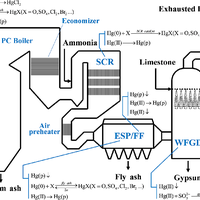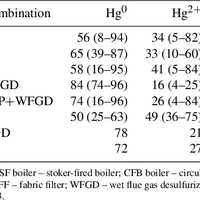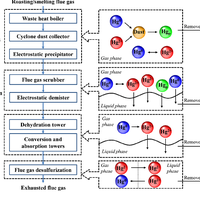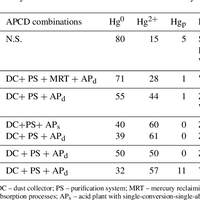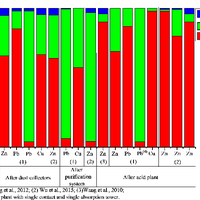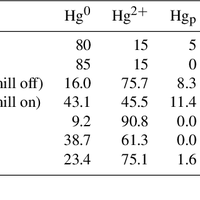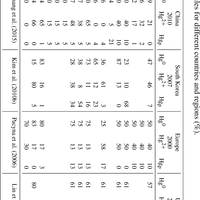Abstract
Mercury transformation mechanisms and speciation profiles are reviewed for mercury formed in and released from flue gases of coal-fired boilers, non-ferrous metal smelters, cement plants, iron and steel plants, waste incinerators, biomass burning and so on. Mercury in coal, ores, and other raw materials is released to flue gases in the form of Hg0 during combustion or smelting in boilers, kilns or furnaces. Decreasing temperature from over 800 °C to below 300 °C in flue gases leaving boilers, kilns or furnaces promotes homogeneous and heterogeneous oxidation of Hg0 to gaseous divalent mercury (Hg2+), with a portion of Hg2+ adsorbed onto fly ash to form particulate-bound mercury (Hgp). Halogen is the primary oxidizer for Hg0 in flue gases, and active components (e.g., TiO2, Fe2O3, etc.) on fly ash promote heterogeneous oxidation and adsorption processes. In addition to mercury removal, mercury transformation also occurs when passing through air pollution control devices (APCDs), affecting the mercury speciation in flue gases. In coal-fired power plants, selective catalytic reduction (SCR) system promotes mercury oxidation by 34-85 %, electrostatic precipitator (ESP) and fabric filter (FF) remove over 99 % of Hgp, and wet flue gas desulfurization system (WFGD) captures 60-95 % of Hg2+. In non-ferrous metal smelters, most Hg0 is converted to Hg2+ and removed in acid plants (APs). For cement clinker production, mercury cycling and operational conditions promote heterogeneous mercury oxidation and adsorption. The mercury speciation profiles in flue gases emitted to the atmosphere are determined by transformation mechanisms and mercury removal efficiencies by various APCDs. For all the sectors reviewed in this study, Hgp accounts for less than 5 % in flue gases. In China, mercury emission has a higher Hg0 fraction (66-82 % of total mercury) in flue gases from coal combustion, in contrast to a greater Hg2+ fraction (29-90 %) from non-ferrous metal smelting, cement and iron and/or steel production. The higher Hg2+ fractions shown here than previous estimates may imply stronger local environmental impacts than previously thought, caused by mercury emissions in East Asia. Future research should focus on determining mercury speciation in flue gases from iron and steel plants, waste incineration and biomass burning, and on elucidating the mechanisms of mercury oxidation and adsorption in flue gases.
Figures
Register to see more suggestions
Mendeley helps you to discover research relevant for your work.
Cite
CITATION STYLE
Zhang, L., Wang, S., Wu, Q., Wang, F., Lin, C. J., Zhang, L., … Hao, J. (2016). Mercury transformation and speciation in flue gases from anthropogenic emission sources: A critical review. Atmospheric Chemistry and Physics, 16(4), 2417–2433. https://doi.org/10.5194/acp-16-2417-2016

